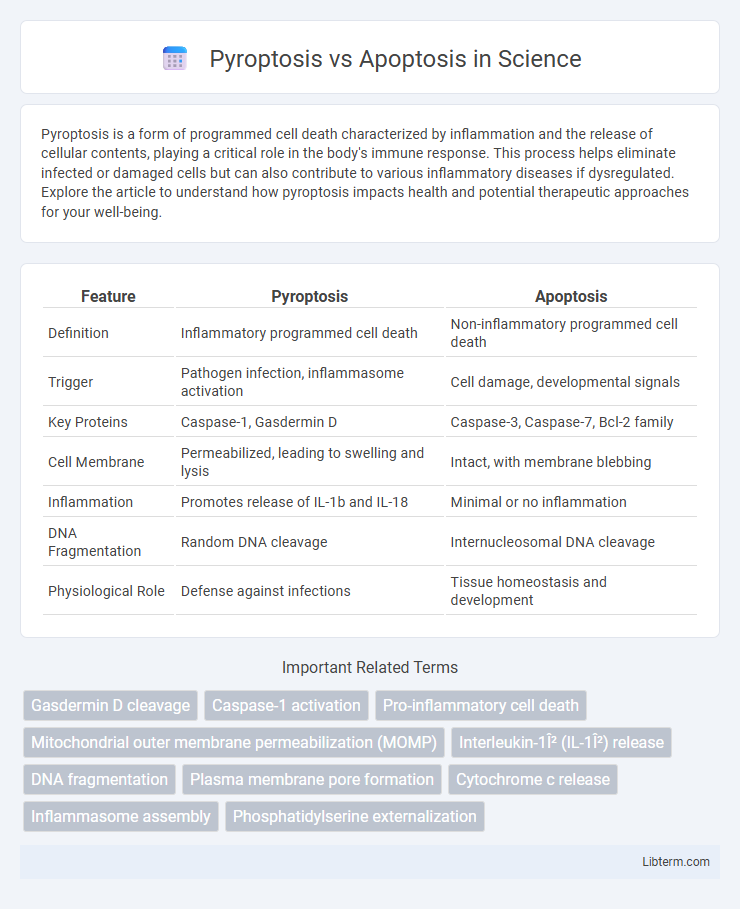Pyroptosis is a form of programmed cell death characterized by inflammation and the release of cellular contents, playing a critical role in the body's immune response. This process helps eliminate infected or damaged cells but can also contribute to various inflammatory diseases if dysregulated. Explore the article to understand how pyroptosis impacts health and potential therapeutic approaches for your well-being.
Table of Comparison
| Feature | Pyroptosis | Apoptosis |
|---|---|---|
| Definition | Inflammatory programmed cell death | Non-inflammatory programmed cell death |
| Trigger | Pathogen infection, inflammasome activation | Cell damage, developmental signals |
| Key Proteins | Caspase-1, Gasdermin D | Caspase-3, Caspase-7, Bcl-2 family |
| Cell Membrane | Permeabilized, leading to swelling and lysis | Intact, with membrane blebbing |
| Inflammation | Promotes release of IL-1b and IL-18 | Minimal or no inflammation |
| DNA Fragmentation | Random DNA cleavage | Internucleosomal DNA cleavage |
| Physiological Role | Defense against infections | Tissue homeostasis and development |
Understanding Pyroptosis and Apoptosis
Pyroptosis is a form of programmed cell death characterized by cellular swelling, membrane pore formation, and release of pro-inflammatory cytokines like IL-1b, primarily triggered by inflammasome activation. Apoptosis involves controlled cell shrinkage, chromatin condensation, DNA fragmentation, and membrane blebbing, typically mediated by caspases such as caspase-3 without eliciting inflammation. Understanding the molecular pathways and regulatory caspases differentiates pyroptosis as an inflammatory response, whereas apoptosis maintains tissue homeostasis through non-inflammatory cell clearance.
Molecular Mechanisms of Pyroptosis
Pyroptosis is a pro-inflammatory form of programmed cell death primarily mediated by the activation of inflammatory caspases, such as caspase-1, caspase-4, and caspase-5 in humans, which cleave gasdermin D to form pores in the cellular membrane, leading to cell swelling and lysis. Key molecular components include the inflammasome complex, responsible for sensing pathogenic or stress signals, and the subsequent release of pro-inflammatory cytokines IL-1b and IL-18. Unlike apoptosis, which involves caspase-3 and caspase-7 leading to non-inflammatory cell dismantling, pyroptosis results in a robust immune response due to plasma membrane rupture and cytokine release.
Key Pathways in Apoptosis
The key pathways in apoptosis include the intrinsic pathway, governed by mitochondrial outer membrane permeabilization and cytochrome c release, and the extrinsic pathway, initiated by death receptor activation such as Fas and TNF receptors. Caspase activation is central to apoptosis, with initiator caspases like caspase-8 and caspase-9 triggering executioner caspases such as caspase-3 and caspase-7, leading to controlled cell dismantling. Unlike pyroptosis, which is inflammatory and mediated by gasdermin proteins after inflammasome activation, apoptosis is a non-inflammatory, programmed cell death process essential for tissue homeostasis.
Triggering Factors: Pyroptosis vs Apoptosis
Pyroptosis is primarily triggered by infections and intracellular danger signals that activate inflammasomes, leading to caspase-1 activation and gasdermin-mediated cell membrane pore formation. Apoptosis is initiated by intrinsic signals like DNA damage or extrinsic signals such as death receptor engagement, activating caspases-3, -6, and -7 to orchestrate controlled cell dismantling. These distinct triggering mechanisms underline pyroptosis's role in inflammatory responses versus apoptosis's function in non-inflammatory programmed cell death.
Morphological Differences Between Pyroptosis and Apoptosis
Pyroptosis is characterized by cell swelling, plasma membrane rupture, and release of pro-inflammatory intracellular contents, whereas apoptosis involves cell shrinkage, chromatin condensation, and formation of apoptotic bodies without membrane rupture. The morphological hallmark of pyroptosis is the formation of large plasma membrane pores leading to cell lysis, contrasted by the intact membrane and controlled dismantling of intracellular components in apoptosis. These distinct morphological features reflect their differing roles in inflammatory and non-inflammatory cell death processes.
Inflammatory Responses: Contrasting Outcomes
Pyroptosis triggers a robust inflammatory response by releasing pro-inflammatory cytokines such as IL-1b and IL-18 through gasdermin D pore formation, leading to cell swelling and lysis. In contrast, apoptosis is a non-inflammatory process characterized by cell shrinkage, membrane blebbing, and phagocytosis of apoptotic bodies without cytokine release. The differential activation of inflammasomes in pyroptosis versus caspase cascades in apoptosis defines their contrasting roles in immune regulation and tissue homeostasis.
Biological Roles in Disease and Immunity
Pyroptosis, a highly inflammatory form of programmed cell death driven by gasdermin-mediated membrane pore formation, plays a critical role in host defense against infections by promoting immune cell recruitment and cytokine release. In contrast, apoptosis is a non-inflammatory, caspase-dependent process crucial for tissue homeostasis and the elimination of damaged or infected cells without triggering an immune response. Dysregulation of pyroptosis contributes to inflammatory diseases and autoimmune disorders, while defects in apoptosis pathways are linked to cancer progression and immune evasion.
Detection Methods for Pyroptosis and Apoptosis
Detection methods for pyroptosis primarily involve assessing inflammasome activation, caspase-1 cleavage, and the release of IL-1b and IL-18 cytokines using techniques like Western blotting, ELISA, and flow cytometry. Apoptosis detection relies on identifying caspase-3 activation, DNA fragmentation via TUNEL assay, and phosphatidylserine exposure using Annexin V staining combined with flow cytometry or microscopy. Both pathways can be differentiated by monitoring specific molecular markers, such as gasdermin D cleavage for pyroptosis and PARP cleavage for apoptosis, enhancing the accuracy of cell death classification.
Therapeutic Implications and Challenges
Pyroptosis, a pro-inflammatory form of programmed cell death mediated by gasdermin proteins, offers therapeutic potential in cancer and infectious diseases by enhancing immune responses, contrasting with apoptosis, which is a non-inflammatory process crucial for tissue homeostasis. Targeting pyroptosis can overcome resistance to apoptosis-inducing drugs, yet challenges include controlling excessive inflammation and avoiding unintended tissue damage. Developing selective modulators of pyroptotic pathways remains critical for harnessing their therapeutic benefits while minimizing adverse effects.
Future Perspectives in Cell Death Research
Future perspectives in cell death research emphasize the therapeutic targeting of pyroptosis and apoptosis to treat inflammatory diseases and cancer. Advances in understanding molecular regulators such as gasdermins in pyroptosis and caspases in apoptosis enable precise modulation of these pathways for improved clinical outcomes. Emerging technologies like single-cell sequencing and CRISPR screening will accelerate the discovery of novel biomarkers and intervention strategies.
Pyroptosis Infographic

 libterm.com
libterm.com